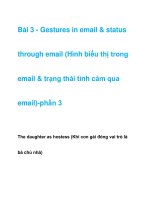4 1 3 childhood in pre war japan
Bạn đang xem bản rút gọn của tài liệu. Xem và tải ngay bản đầy đủ của tài liệu tại đây (8.01 MB, 12 trang )
Suggested levels for Guided Reading, DRA,™
Lexile,® and Reading Recovery™ are provided
in the Pearson Scott Foresman Leveling Guide.
Childhood
in Pre-War Japan
Genre
Expository
nonfiction
Comprehension
Skills and Strategy
• Sequence
• Compare and
Contrast
• Graphic Organizers
Text Features
•
•
•
•
Captions
Map
Sidebar
Table of Contents
Scott Foresman Reading Street 4.1.3
ISBN 0-328-13419-8
ì<(sk$m)=bdebj < +^-Ä-U-Ä-U
by Jana Martin
Vocabulary
Reader Response
amazed
1. Which country came to Japan first, Portugal or
the United States?
bewildered
homeland
longed
sculptures
still
2. Make a graphic organizer to show some
differences between how girls and boys were
raised in traditional Japan. Then summarize how
each was raised.
Childhood
Girls
Boys
in Pre-War Japan
towering
Word count: 1,832
3. The word still has several different meanings.
Choose the meaning that is used on page 14 of
this book.
a. still: without motion: The ocean is still today.
b. still: to make quiet: Still that barking dog.
c. still: even to this time: The store was still open.
by Jana Martin
4. Choose the glossary words that complete the
second sentence: When Kim visited the United
States, she was very homesick. She _____ to return
to her ______.
Note: The total word count includes words in the running text and headings only.
Numerals and words in chapter titles, captions, labels, diagrams, charts, graphs,
sidebars, and extra features are not included.
Editorial Offices: Glenview, Illinois • Parsippany, New Jersey • New York, New York
Sales Offices: Needham, Massachusetts • Duluth, Georgia • Glenview, Illinois
Coppell, Texas • Ontario, California • Mesa, Arizona
TABLE OF CONTENTS
Introduction
4
CHAPTER 1
An Ancient Culture
6
CHAPTER 2
Early Japan
10
CHAPTER 3
The Threat of Outsiders
13
CHAPTER 4
Every effort has been made to secure permission and provide appropriate credit for
photographic material. The publisher deeply regrets any omission and pledges to
correct errors called to its attention in subsequent editions.
Unless otherwise acknowledged, all photographs are the property of Scott Foresman,
a division of Pearson Education.
Life for Children
15
SUMMARY
19
GLOSSARY
20
Photo locators denoted as follows: Top (T), Center (C), Bottom (B), Left (L), Right (R),
Background (Bkgd)
Cover: ©Michael Maslan Historic Photographs/Corbis; 1 ©Michael Maslan Historic
Photographs/Corbis; 4–5 (Bkgd) ©Free Agents Limited/Corbis; (L) ©Haruyoshi
Yamaguchi/Corbis Sygma, (B) ©Peter M. Wilson/Corbis; 5 ©Tom Wagner/Corbis
Saba; 6 ©Michael Maslan Historic Photographs/Corbis; 8 ©Peter Harholdt/Corbis;
10 ©Wolfgang Kaehler/Corbis; 11 ©Bohemian Nomad Picturemakers/Corbis; 12–13
©Bass Museum of Art/Corbis; 14 (T) ©Medford Historical Society Collection/Corbis, (B)
©Michael Maslan Historic Photographs/Corbis; 15 ©Bettmann/Corbis; 16 ©Michael
Maslan Historic Photographs/Corbis; 17 (T) ©Bettmann/Corbis, (B) ©Hulton-Deutsch
Collection/Corbis; 19 (L) ©Hulton-Deutsch Collection/Corbis, (R) ©Corbis
ISBN: 0-328-13419-8
Copyright © Pearson Education, Inc.
All Rights Reserved. Printed in China. This publication is protected by Copyright,
and permission should be obtained from the publisher prior to any prohibited
reproduction, storage in a retrieval system, or transmission in any form by any
means, electronic, mechanical, photocopying, recording, or likewise. For information
regarding permission(s), write to: Permissions Department, Scott Foresman, 1900 East
Lake Avenue, Glenview, Illinois 60025.
4 5 6 7 8 9 10 V0H3 14 13 12 11 10 09 08 07 06
3
Modern Tokyo, Japan, is a city full
of lights, energy, inventions, and fun.
Introduction
What do you think of when you think of
Japan? You might think of colorful, bright
lights, towering office buildings, or powerful
Japanese companies. Some of the world’s most
popular cars and electronics are made by these
companies. Lots of great ideas come from
Japan—from computers to robots to pinball
games. In fact, modern Japan is one of the most
successful nations in the world.
Students eat lunch in their Tokyo
classroom.
Japan is very old, but it is also very young.
World War II practically destroyed many
countries, including Japan. When Japan rebuilt
itself after the war, it wanted to be a strong,
successful nation.
Modern Japan borrowed ideas from
Western—American and European—ways of
life and mixed them with its own. Japanese
children today enjoy American products and
entertainment. Similarly, American life is full of
products and ideas from Japan. But this mixture
of cultures is fairly new.
4
5
Chapter 1
An Ancient Culture
Before World War II, Japan was a very
different place. It avoided outside influences.
It was a nation that valued traditions and took
pride in its unique history. It chose to turn away
from the outside world.
Japan focused on its past to gain strength
for the future. Children were taught Japanese
history and culture and ancient customs and arts.
They were taught how to behave according to
Japanese tradition and to value their homeland.
Japan’s civilization is thousands of years old.
So what was life like for children in old Japan?
Four main islands and thousands of smaller islands make
up Japan. Tip to tip, this chain of islands is about 1,500
miles long. If all the islands were connected, Japan
would be about the same size as California.
A Nation of Islands
Japanese children wear traditional
costumes for festival celebrations.
6
Japan is a nation of islands. Four main islands
are surrounded by thousands of smaller ones. In
school, Japanese children learn that these islands
are actually the tops of old volcanoes. But the
children also learn an ancient legend of how
Japan came to be.
7
How Japan Came to Be
Long ago, two gods were put in charge of
creating the world. They were Izanagi, the god
of light and heavens, and his wife, Izanami. One
day, they stood on a floating bridge in the sky,
admiring the ocean. They had a beautiful spear
with them. It was covered with jewels. Suddenly,
they threw the spear into the ocean.
In an ancient Japanese myth, two
gods create all the islands of Japan.
Japanese children have always been taught
the “two sides” of Japan. One side includes
Japan’s wonderful stories and traditions. The
other side includes scientific explanations and
practical knowledge.
In school, Japanese children learn the famous
tales and traditions that lasted through the
centuries. In this way they are connected to the
past. They also learn the latest knowledge, such
as math and science, so that they are able to
succeed in the future. Japan wants its children to
be respectful, strong, and smart.
Let’s take a look at some of the history that
shaped this country.
Japan’s flag is a red sun on
a white background. It was
adapted from a design that
is thousands of years old.
When Izanagi and Izanami pulled the spear
back out of the ocean, water dripped off the
spear. As the first drop fell down into the sea, it
created the first island. Every drop of water that
fell from the spear turned into another island.
Soon, thousands of islands dotted the ocean, like
jewels in the sea.
8
About 70 percent of Japan is
mountainous. Mount Fuji, shown here,
is Japan’s tallest mountain.
9
Chapter 2
Early Japan
Thousands of years ago, Japan’s islands
were a variety of small countries. The people
who lived on these islands were hunters,
gatherers, and fishermen. Then, around
300 B.C., rice came to Japan. The Japanese
began to grow and harvest it. As Japanese
agriculture developed, so did society. Towns
and villages arose. Governments were formed.
Gradually, the small countries formed into one
nation ruled by an emperor.
Ancient Japan’s original religion was called
Shinto. Shinto celebrates the natural world—
the wind, trees, rain, snow, rivers, oceans,
mountains, and sun. It says that a spirit is
connected to everything—even rice. It honors
ancestors so that they are not forgotten. From
Shinto came the Japanese traditions of seeing
beauty in the natural world.
A famous Shinto gate
stands near Mount Fuji.
It is painted in traditional
Shinto colors: orange and
black. Shinto means “the
way of the gods.”
10
Japanese writing is
based on Chinese
character writing.
During the sixth century A.D., Shinto was
joined by another religion: Buddhism. This was
also the time in Japanese history when written
language developed.
Contact with Chinese traders helped bring
Chinese character writing to Japan. The Chinese
characters, or signs, were adapted to the
Japanese language.
Around the same time, contact with friendly
rulers from neighboring Korea brought
Buddhism to Japan. Educated Japanese nobles
made Buddhism the state religion. They enjoyed
its ideas. But the people of rural areas, such as
fishing villages or farming towns, still preferred
Shinto. With its focus on nature, Shinto made
more sense in their world. Also, many rural
Japanese then did not know how to read or
write. They found Buddhism hard to understand.
11
As Japan developed, new cities grew. By
the eighth century, Kyoto was the capital city.
Kyoto was full of life and culture, much like
big cities today. There was wonderful poetry
and literature, music and theater. During
that time, Japanese society developed special
customs and rules for nearly everything—from
entertaining guests to writing letters. This
was also a great time for art. Japanese artists
created amazing sculptures and statues.
Builders created beautifully designed temples.
The Code of the Warrior
Another tradition was also developing.
By A.D. 1100, Japan saw the beginning of a
more military kind of rule. Warring groups
developed into organized armies. These
armies featured fierce warriors, called
samurai. Samurai were fearless and strong.
They were extremely skilled swordfighters.
Most importantly, they were absolutely loyal
to those they served. They lived according to
this code of strength and loyalty. Stories of
heroic samurai spread. The idea of the proud
Japan’s tradition of the fierce samurai warrior
and loyal
warrior
became
veryyears
important
to
began
nearly
a thousand
ago.
Japanese society.
12
Chapter 3
The Threat of Outsiders
For hundreds of years, Japan went
without contact with Europe. Then,
in 1543, a ship from Portugal wrecked
in southern Japan. For the first time,
Japanese people met Europeans.
The Japanese were amazed to see
something very new—guns.
Soon Portugese and European
merchants were trading with
Japan. Some Portugese also tried to
bring another product to Japan—
Christianity. Japan’s rulers saw this
as a threat to their society. To make
sure the Japanese did not lose their
own customs and traditions, the
rulers closed Japan’s borders to most
traders. They also created a law that
said Japanese people could not travel
outside their homeland.
This law lasted for more than two
hundred years. During that time, the
nation enjoyed a period of peace, and
Japanese rulers helped the economy
become stronger.
13
In 1853, Americans
visited Japan.
But Japan could not
stay isolated, or separate,
forever. In 1853, a U.S.
warship commanded by
Matthew C. Perry sailed
Matthew C. Perry
into a Japanese harbor.
Perry carried a letter
from the U.S. President. President Fillmore asked
that Japan open its borders and begin trading
with the United States.
The appearance of these outsiders bewildered
many Japanese. However, Japan’s rulers realized
that, in order to grow, Japan had to trade with
other countries. So they had to still any protests
from the people.
These leaders decided that the time had come
to accept new ideas and new trade goods. One
Japanese ruler even told his people to “learn all
you can from the Europeans and the Americans.”
Chapter 4
Life for Children
From Perry’s arrival in 1853
until the 1930s, Japan grew from
an isolated country into a
powerful nation. It built up an
army and navy. It developed
cities and industries. It was also
involved in wars with its
neighbors, Russia and China.
But it kept its customs.
Japan was still ruled by an
emperor, whose family traced
back to old Japanese nobility. Emperor Hirohito took
the throne to rule Japan
Most people still attended
in 1926. Children paraded
Buddhist or Shinto temples.
throughout the nation in
his honor and dressed as
Traditional Japanese arts,
literature, music, and theater the samurai of long ago.
were still greatly enjoyed. Most people still kept
traditional Japanese homes. They slept on cotton
mattresses called futons. Rooms were divided by
paper screens, and floors were covered by straw
mats. Meals were eaten sitting on the floor at
low tables. All people took their shoes off before
going inside.
In the 1890s, a group of
children paraded down a
street in Japan, carrying
flags and paper lanterns.
14
15
Japanese girls in the past
often had to care for their
younger sisters and brothers.
Kendo, a form of sword fighting, is one of
Japan’s traditional martial arts. Here, Japanese
boys demonstrate their skill in the 1930s.
Girls and Boys
In traditional Japan, there were different rules
for how girls and boys should act. Japanese girls
learned how to be quiet and well-mannered.
They learned how to look their best. They
learned traditional dances, flower arranging,
how to cook, and how to make a pleasant home.
But girls also had to work hard. In some
families, especially in rural villages, Japanese
girls were expected to take care of their younger
brothers and sisters. They often worked in the
fields with babies strapped to their backs. At
home, girls were expected to be polite and not
disagree with their parents. In some places, girls
did not even get to go to school. Many longed
for a chance to learn what their brothers learned.
16
Japanese boys learned how to be warriors. In
traditional Japanese culture, boys were expected
to be louder than girls and even to “boss”
their sisters around. They were expected to be
physically active. They learned martial arts, such
as sword fighting and wrestling.
Japanese boys could not always show their
fear or emotions. Instead, they had to be strong,
as if they were soldiers. If they lived in rural
fishing or farming areas, they helped their
fathers on the boats or in the fields.
Every November 15, Japanese
children visit Shinto shrines to ask for
good luck. In the 1930s, these boys
went dressed in miniature military
uniforms, a sign of the national pride
of the time.
17
By the 1930s, Japan was at war with China. It
was also becoming swept up in the international
problems that led to World War II.
To prepare for war, Japan needed all of its
resources. Families gave up metal pots and pans.
These were melted down to make weapons.
Children wore homemade clothes so that
materials and factories could be used for making
uniforms. The government even created rules for
what people could wear. People were supposed
to speak Japanese only, not English or European
languages.
But even then, children still had fun. The
government actually reminded parents to make
sure their children were happy! There was even a
holiday called Children’s Day on the fifth of May.
At this celebration, children in cities would fly
giant fish kites from their rooftops. They made
tall bamboo stilts and walked through the streets
feeling taller than anyone!
After the terrible damage of World War II, Japan
had to recover. Soon it was on its way to becoming
a major world power. But even now, in the twentyfirst century, children still learn their traditions and
the legend of how Japan came to be.
18
A Japanese girl in the
1930s learns how to play
a traditional musical
instrument.
In 1937, a Japanese school
teacher helps his students
with their writing lesson.
Summary
Japan is thousands of years old. Over time it
developed into a strong society with rich customs
and traditions.
Most Japanese observed either the Shinto
or Buddhist religion. Strong, loyal warriors
defended Japan’s rulers. When outsiders came to
Japan in 1543 and again in 1853, Japan reacted.
The first time, it closed its doors. The second
time, it opened them, but kept its own traditions
and society strong.
Japanese children always learned the country’s
traditions and customs. They also learned
practical knowledge to become successful in the
future. Girls were taught to be quiet and helpful,
while boys were taught to be strong and tough.
Both boys and girls learned wonderful customs
and celebrated many holidays.
In the 1930s, Japan was at war with China and
readying for World War II. After World War II,
Japan changed forever.
19
Glossary
Vocabulary
Reader Response
amazed
amazed
v. to have
surprised greatly.
longed v. to have
wanted very much.
confused completely.
sculptures n. models
made of stone or metal.
bewildered
bewildered v. to have
homeland
homeland n. country
that
is one’s home.
longed
still v. to make quiet.
towering adj. very high.
1. Which country came to Japan first, Portugal or
the United States?
2. Make a graphic organizer to show some
differences between how girls and boys were
raised in traditional Japan. Then summarize how
each was raised.
Girls
Boys
sculptures
still
towering
Word count: 1,832
3. The word still has several different meanings.
Choose the meaning that is used on page 14 of
this book.
a. still: without motion: The ocean is still today.
b. still: to make quiet: Still that barking dog.
c. still: even to this time: The store was still open.
4. Choose the glossary words that complete the
second sentence: When Kim visited the United
States, she was very homesick. She _____ to return
to her ______.
Note: The total word count includes words in the running text and headings only.
Numerals and words in chapter titles, captions, labels, diagrams, charts, graphs,
sidebars, and extra features are not included.
20









